

Full of Zest: Shizuoka’s Wasabi Fields
|
Shizuoka is often described as verdant – though it is situated between the urban metropolises of Tokyo and Nagoya, Shizuoka is replete with nature’s bounties. Aside from the iconic Mt Fuji, Shizuoka is also well-known for its lush forests, pristine beaches, and natural hot springs. The prefecture’s climate and topography also make it a perfect place to cultivate agricultural products like green tea. In fact, Shizuoka accounts for more than 40% of domestic green tea production! However, did you know that the prefecture is closely associated with another beloved green agricultural product?
Wasabi paste is a quintessential condiment in Japanese cuisine, paired mainly with sushi and sashimi. It can be dabbed in between seafood toppings and rice in nigiri-sushi, or dissolved in soy sauce to be used as a dip. The zest that pierces through your nose when ingested can be momentarily uncomfortable but the wasabi paste serves as the perfect accompaniment to seafood dishes as it removes any fishy smells and enhances the food’s fresh flavour. This green paste is made from the roots of the wasabi plant, which is native to Japan. It can be found growing in wild mountainous areas across the country and records of its use in local cuisine dates back many centuries, but it was not until the early 1600s that farmers in the Utogi District (now part of Shizuoka) began cultivating it. They planted their wasabi plants near sources of spring water, producing such high-quality wasabi that they came to be favoured by Tokugawa Ieyasu, the then shogun ruler of Japan. They went on to monopolise wasabi cultivation and production until the mid-18th century - knowledge on how to cultivate wasabi soon began spreading to the neighbouring Izu region. It is thanks to the work put into cultivating wasabi in the Utogi and Izu areas that have made wasabi synonymous with Shizuoka prefecture. There are two main methods of traditional wasabi cultivation. The first is the Jizawa style, which is actually the oldest wasabi cultivation method in Japan, and has been used since the farmers began cultivating the plant. Farmers spread pebbles and sand to create wasabi fields on steep, sloping mountainsides to take advantage of the fresh spring water that flows unceasingly from the top of the mountain. This method made wasabi cultivation possible in areas where farmers were not able to plough soil too deep. The second method was developed in the Izu region in the late 19th century. In the Tatamiishi style, rocks are layered into wasabi fields that are dug deep into the ground: the bottom layer is first reinforced with large rocks, and each subsequent layer is piled with smaller rocks. Flowing spring water from mountainside streams are also utilised in this method to water the fields. |
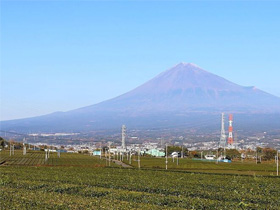 © Matt Evans 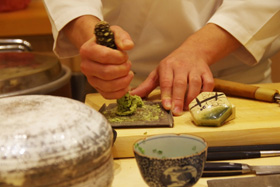 © photoAC 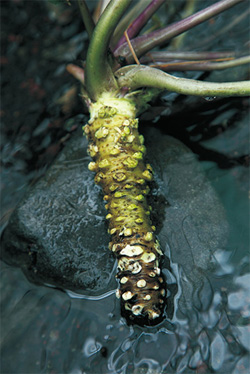 © Natori Kazuhisa 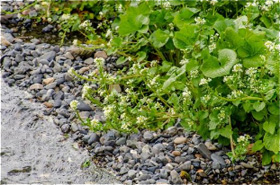 © photoAC |
|
Both the Jizawa and Tatamiishi styles strike a balance between a constant water flow and a solid rock foundation. A constant flow of clean and fresh spring water not only supplies wasabi plants with nutrients and oxygen, but also helps to wash away impurities in the soil that could cause disease. The rocks work to control the volume of water that flows through the wasabi fields - they block the soil from permeating too much water, ensuring a constant flow of water through the fields.
Because of how nutritious the spring water is, farmers have no need for fertilisers or chemicals to boost production. As such, the environment around wasabi fields still retains a robust and high level of biodiversity, including numerous rare and threatened species. Furthermore, these methods of wasabi cultivation do little to disrupt the water cycle. The same spring water that is used to water wasabi fields can therefore be used again downstream to cultivate rice and farm freshwater fish. The water later flows into the ocean, which evaporates and turns into rain or snow, starting the cycle anew. The use of these traditional methods to grow wasabi in these regions have helped Shizuoka become the top wasabi producing prefecture in Japan. Wasabi from Shizuoka are known to be of superior quality with exceptionally thick roots; wasabi paste is made from grating the roots of the wasabi plant, and so having thick roots give the plants high market value. However, it is actually not easy to get a taste of real, pure wasabi paste. Wasabi is slow-growing plant and it can often take up to 3 years for it to grow large enough to be harvested. As it is hard to meet the growing demand for wasabi as Japanese cuisine gains popularity across the world, some restaurants instead use a cheaper mixture of horseradish, mustard, and food colouring. This ‘wasabi’ mixture has a sharper, more pungent taste than pure grated wasabi, which is milder and has a watery consistency. If you ever find yourself in the mountains of Shizuoka, make sure you indulge in a meal to have a taste of real, Shizuoka-grown wasabi! |
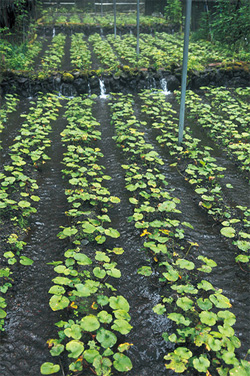 © Natori Kazuhisa 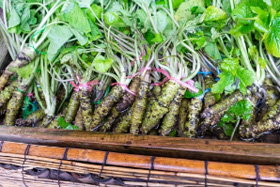 © photoAC 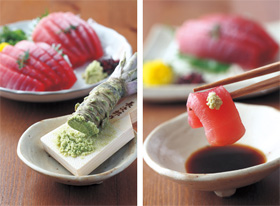 © Natori Kazuhisa |
Resources
|
Agriculture, Forestry, and Fisheries in Shizuoka. Retrieved 24 June 2021, from http://www.pref.shizuoka.jp/a_foreign/english/glance/agriculture.html |
|
Japan Creative Centre 4 Nassim Road, Singapore 258372 +65 6737 0434 / jcc@sn.mofa.go.jp https://www.sg.emb-japan.go.jp/JCC/ Nearest parking at Orchard Hotel & Delphi Orchard |
 |